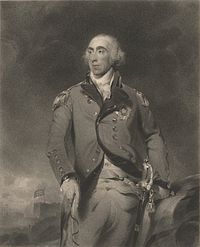Charles Grey, 1st Earl Grey

Charles Grey, 1st Earl Grey, KB (23 October 1729–14 November 1807) was one of the most important British generals of the 18th century. He was the fourth son of Sir Henry Grey, Bt., of Howick in Northumberland.
Military career
Charles received a commission as an ensign in 1748. By December 1752 he was serving as a lieutenant in the 6th Regiment of Foot. Subsequently, he raised a company of men on his own and joined the 20th Regiment, in which James Wolfe served as lieutenant colonel. In 1757, while with Wolfe's regiment, he participated in the unsuccessful attack on Rochefort.
Seven Years' War
In the Seven Years' War, he served as adjutant in the staff of Duke Ferdinand of Brunswick and on August 1, 1759 was wounded at Minden. On October 14, 1760 he commanded a Light Company at the Battle of Campen, where he was again wounded. One year later, as Lt. Colonel of the 98th Foot, he participated in the siege of Belle Isle, off the coast of Britanny. Next, he served at the Battle of Havana in 1762. Later, he was on the staff of Wilhelm, Count of Schaumburg-Lippe during the Spanish invasion of Portugal (1762). In 1763 he retired on half-pay, but in 1772 he received a promotion to Colonel and served as aide-de-camp to King George III.
American War of Independence
During the American War of Independence he was one of the more successful army leaders. He was rapidly promoted, becoming a Major General in 1777. He earned the nickname "No-flint Grey" after the Paoli Massacre nighttime attack of 1777, before which he had collected flints from the muskets of his troops before they engaged the American revolutionaries using bayonets, thus maintaining the element of surprise. Immediately thereafter, he commanded the 3d Brigade at the Battle of Germantown.
In 1778 he led raids at New Bedford on September 5-6, destroying nearly all the shipping and burning twenty shops and twenty-two houses in the town, and Martha's Vineyard, where between September 10 and 15, the British carried off all the sheep, swine, cattle and oxen that they could find with promise of payment in New York. Grey then used the same tactic as he had at Paoli in the Baylor Massacre. He was recalled to England and became a knight of the Order of the Bath and a lieutenant general. He later was appointed commander-in-chief of the British troops in America, but hostilities ended before he could take command.
French Revolutionary Wars
At the outset of the war with Revolutionary France, in 1793, Sir Charles Grey was appointed commander of the West Indian expedition. First, however, he went to Ostend to participate in the relief of Nieuwpoort, Belgium. In early 1794, he and Admiral Sir John Jervis led a British force to capture Martinique. The campaign lasted about six weeks with the British capturing Fort Royal and Fort Saint Louis on March 22, and Fort Bourbon two days later. The British then occupied Martinique until the Treaty of Amiens returned the island to the French in 1802.
Peerage
In late 1794 he returned to England. From 1798 to 1799 he served as Commander of the Southern District, retiring in 1799. In acknowledgment of his service, he was raised in January 1801 to the peerage as Baron Grey of Howick. In 1806, he was created Earl Grey and Viscount Howick. He died the next year, at the age of 78.
Family
In 1762, Grey married Elizabeth Grey (1744-1822), the daughter of George Grey of Southwick (1713-1746), their sons were:
- Charles Grey, 2nd Earl Grey, British statesman and prime minister after whom Earl Grey tea is named.
- George Grey (1767 - 1828), whose daughter Hannah Jean married Sir Henry Thompson, 3rd Baronet
- William Grey (1777 - 1817)
- Edward Grey (1782 - 1837)
He was also an ancestor of Prime Ministers Anthony Eden and Alec Douglas-Home, and of Eliza Courtney and Diana, Princess of Wales.
Sources
- John C. Fredriksen, 2001, America's Military Adversaries: From Colonial Times to the Present, (ABC-CLIO), p. 203.
